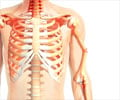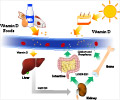Calcium and vitamin D supplementation, even over a short time period, can significantly reduce stress fractures in female military recruits.
Calcium and vitamin D supplementation, even over a short time period, can significantly reduce stress fractures (overuse injuries to the bone) in female military recruits, according to a study.
The randomized, double-blind study, funded by the U.S. Department of Defense, looked at 5,201 female U.S. Navy recruits during eight weeks of basic training from 2002 to 2006 at Great Lakes Naval Station near Chicago, Ill.The women, ages 17 to 35, were divided into two groups with one group receiving daily pill supplements of 2,000 Mg of calcium and 800 IU of vitamin D, and the other group receiving placebo pills. Calcium supports bone formation and repair, while vitamin D helps the body absorb calcium.
During the study, 170 recruits in the placebo group experienced stress fractures, about 25 percent more than in the group taking the calcium/vitamin D supplements. A history of regular exercising decreased the risk of stress fractures, while cigarette smoking increased the risk.
“What really surprised us is that calcium/vitamin D supplements made a significant difference in such a short period of time. Frankly, we were not sure we would see any statistically significant results in only eight weeks,” said principal investigator Joan Lappe, Ph.D., R.N., a professor of nursing and medicine at Creighton University in Omaha, Neb.
Stress factures are one of the most common and debilitating overuse injuries seen in U.S. military recruits in all branches of the Armed Forces. The rates of stress fracture for females are consistently higher than for males. Estimates are that as many as 21 percent of all female recruits suffer this injury, Lappe noted.
“Stress fractures often lead to chronic pain and disability,” she said. “In addition, the financial impact is enormous in terms of lost costs for recruits discharged from training. One U.S. Army training base estimates the cost at $34,000 per (discharged) soldier, not including expenses related to health care.”
Advertisement
Lappe noted that the study may also have implications for nonmilitary athletic populations, such as high school track and field athletes, in whom stress fractures are also problematic.
Advertisement
Source-Newswise
SRM











